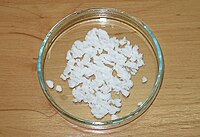Potassium periodate
 |
|
 |
|
| Names | |
|---|---|
|
IUPAC name
Potassium periodate
|
|
| Other names
potassium metaperiodate
|
|
| Identifiers | |
|
3D model (JSmol)
|
|
| ChemSpider | |
| ECHA InfoCard | 100.029.269 |
| EC Number | 232-196-0 |
|
PubChem CID
|
|
|
|
|
|
| Properties | |
| KIO4 | |
| Molar mass | 230.00 g mol−1 |
| Appearance | white crystalline powder |
| Odor | odourless |
| Density | 3.618 g/cm3 |
| Melting point | 582 °C (1,080 °F; 855 K) (decomposes) |
| 0.17 g/100 mL (0 °C) 0.42 g/100 mL (20 °C) 4.44 g/100 mL (80 °C) 7.87 g/100 mL (100 °C) |
|
| Structure | |
| tetragonal | |
| Hazards | |
| Main hazards | Oxidant |
| Safety data sheet | External MSDS |
| NFPA 704 | |
| Related compounds | |
|
Other anions
|
Potassium iodide Potassium iodate |
|
Other cations
|
Sodium periodate |
|
Related compounds
|
Periodic acid |
|
Except where otherwise noted, data are given for materials in their standard state (at 25 °C [77 °F], 100 kPa).
|
|
|
|
|
| Infobox references | |
Potassium periodate is an inorganic salt with the molecular formula KIO4. It is composed of a potassium cation and a periodate anion and may also be regarded as the potassium salt of periodic acid. Note that the pronunciation is per-iodate, not period-ate.
Unlike other common periodates, such as sodium periodate and periodic acid, it is only available in the metaperiodate form; the corresponding potassium orthoperiodate (K5IO6) has never been reported.
Potassium periodate can be prepared by the oxidation of an aqueous solution of potassium iodate by chlorine and potassium hydroxide.
It can also be generated by the electrochemical oxidation of potassium iodate, however the low solubility of KIO3 makes this approach of limited use.
Potassium periodate decomposes at 582 °C to form potassium iodate and oxygen.
The low solubility of KIO4 makes it useful for the determination of potassium and cerium.
It is slightly soluble in water (one of the less soluble of potassium salts, owing to a large anion), giving rise to a solution that is slightly alkaline. On heating (especially with manganese(IV) oxide as catalyst), it decomposes to form potassium iodate, releasing oxygen gas.
KIO4 forms tetragonal crystals of the Scheelite type (space group I41/a).
...
Wikipedia

